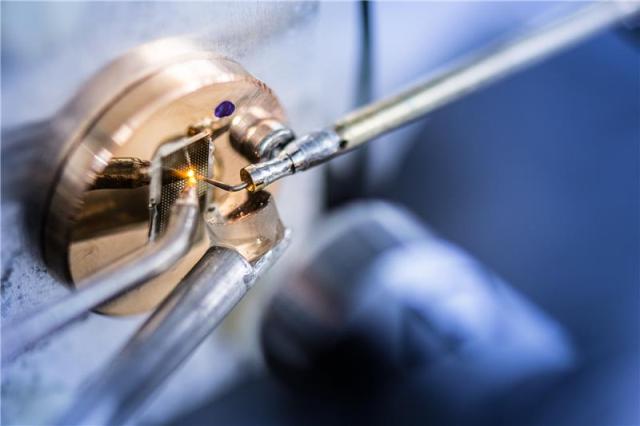Feb 26 2015
RUB engineers have developed a new concept for accelerating data transfer in server farms. To this end, the team at the Chair of Photonics and Terahertz Technology applies a quantum-mechanical variable, i.e. the spin. RUBIN, the science magazine published by the Ruhr-Universität Bochum, reports on how researchers optimise so-called spin lasers for data transfer.
 In order to generate oscillating polarisation, the researchers bend the laser with a nail (left). Thus, the active material is no longer symmetrical and becomes birefringent. Generally speaking, the more strongly a laser is bent, the faster the oscillation. (© RUBIN, photo: Schirdewahn)
In order to generate oscillating polarisation, the researchers bend the laser with a nail (left). Thus, the active material is no longer symmetrical and becomes birefringent. Generally speaking, the more strongly a laser is bent, the faster the oscillation. (© RUBIN, photo: Schirdewahn)
Polarisation oscillation rather than modulation of light intensity
To date, information in server farms is transported directly between individual computers via glass fibre cables. Semiconductor lasers generate light pulses; the information is coded in the changes to light intensity. The faster light intensity is varied, the faster information is transferred. Maximum speed is limited by fundamental physical laws, however. Therefore, the RUB team headed by Prof Dr Martin Hofmann and PD Dr Nils Gerhardt does not modulate light intensity but uses light polarisation instead.
Aligning spins and generating oscillating polarisation
Using a laser, the RUB researchers generate a specific circularly polarised light, in which the polarisation direction oscillates, i.e. alternates between two rotational directions. It is possible to make this oscillation much faster than to change the laser light intensity. The reason: variation of light intensity through electric-current modulation is based on the motion of many electrons that cannot be shifted at any chosen speed. Polarisation oscillation, on the other hand, is based on a quantum-mechanical property of electrons, namely the spin, and the motion of a few electrons is sufficient therefor. By orienting the spins of a group of electrons in the laser into the same direction, the researchers generate oscillating polarisation. They have decoded the underlying effect in detail.